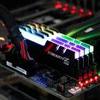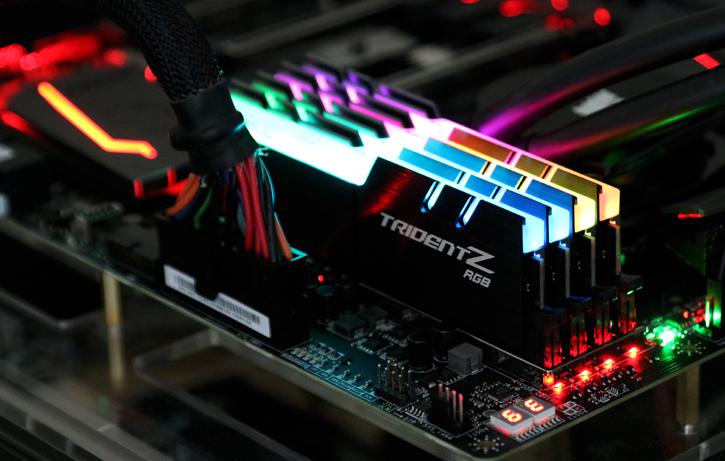Final Words & Conclusion
Final Words & Conclusion
I can think of a dozen reasons why I like the TridentZ RGB series bit the reality remains to be simple though, it ticks all the right boxes. See, you purchase a memory kit of you liking in terms of volume (8/16/32 GB), dual or four DIMM quad channel and then your preferred DIMM clock frequency. We discussed that many times already, extremely fast clocked memory helps, but it is just a tiny little bit. More memory over faster memory is preferred. In quad-channel where you have so much memory bandwidth already that reasoning should be applied, you could easily go for a 2400 MHz kit there. In dual-channel however faster clocked memory can make a litte more sense.
R to the G to the B
The reality though is that this release is all about the RGB LEDs. The trend is on-going, we've seen many poorly designed solutions and implementations, G.Skill however did it right, this memory looks anything short from amazing. Next to that it can be configured to animations and colors of your liking. You can use the in-house G.Skill software, but this memory will also be compatible with ASUS AURA and likely the standards from MSI and Gigabyte as well, I do carefully choose the word likely here so I am not 100% certain about that. Neither did it work with AURA at this time which we tested. With the new TridentZ RGB DIMMs G.Skill simply has a terrific DDR4 memory series available, TridentZ excels in performance, frequency and exquisite looks. This memory just looks great, it is something really special. Honestly each time I look at them the one thing that pops into my mind is the word "Wow".
The DIMMs we tested today are high-density 8GB DIMM modules and as such it is impressive to see that this kit can easily run an up-to 3600 MHz frequency. G.Skill for now only offers 8GB DIMMs, meaning you will be tied towards 16GB, 32GB or a 64GB kit. Our kit does so with a what is considered average latency timings (CL16) and a 1.35 Voltage. Obviously the kit tested today is targeted at the latest series Z170/Z270 Intel motherboard solutions that allow 3600 MHz on that memory, and that's where this 32 GB kit is nice and works nice. Overclocking wise we fooled around with it a little and you will be limited alright, changing CL from results into crashes. So if you are not an uber enthusiast pro-overclocker, your best bet is to simply use the XMP configured timings. I mean, at the XMP default (for this kit) you can already run 3600 MHz.
Conclusion
The final words then, what can I say .. it's G.Skill. Over the past few years they have become one of the most reliable and very well known DIMM memory parters on the globe. They offer sound and properly tested DIMMs. They all work in pretty much any DDR4 enabled PC and they have been tweaked for you. Next to that G.Skill has a wide bracket of products in their portfolio that range from lower clocked to high-frequency and low latency kits. Basically as much as you are willing to spend on a DDR4 memory kit matches something that G.Skill offers. Obviously the TridentZ series is the good stuff, the let's callt hem sexy looking DIMMs for nice options in configurations. Yes, TridentZ DIMMs will be more expensive then your average 2133 MHz memory modules, but not by heaps. It depends greatly on your preferred memory frequency though, a 2400 MHz 4x8 GB kit can go from as low as 7 euro per GB, the RGB version as shown today perhaps two bucks per GB more. For that money you receive DIMMs with a lifetime warranty and that configurable RGB system. Should you ever change your motherboard that has a green theme instead of a red color theme, hey you can switch your DIMMs RGB LEDs to match. The TridentZ series DIMMs are powerful product series aimed at a very specific group of people, the people that want the uber fastest stuff at the high-end of the spectrum and with the niche designed PC, then enthusiast class PC gamer. The kit as tested today is for the guys and gals that want high numbers on everything in their system. The kit remains easy to configure and offers nice quality. From an aesthetic point of view the new TridentZ kits honestly are great looking DIMMs. The performance is great, but slower clocked memory with slightly faster timings will get you the very same end-results and that's the reality folks. High frequency MHz kits remain trivial when it comes to actual real-world performance benefits, so please keep in mind that we deem volume to matter more than frequency. 16GB will be the recommendation for a proper gaming rig and 32GB for more professional usage or to be a little more future proof. Again, G.Skill covers these DIMMs with a limited lifetime warranty as well. Definitely recommended and the new RGB concept, well we just love it as this idea has been properly executed.
- Sign up to receive a notice when we publish a new article
- Or go back to Guru3D's front page



